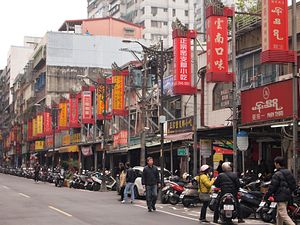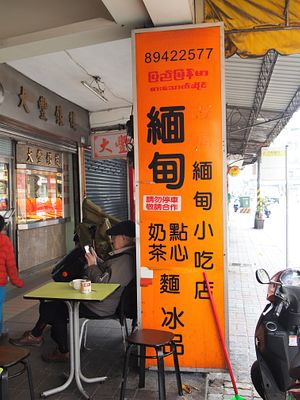A short five-minute walk from the Taipei metro terminal station of Nanshijiao lies Huaxin Street. It is here, nestled away in the concrete jungle that makes up Zhonghe District — one of the most densely populated parts of the planet — that Taiwan’s Burmese population has settled over the past several decades. The roughly 40,000 Burmese immigrants that now call Huaxin Street and the surrounding area home constitute one of Taiwan’s largest immigrant populations.
Huaxin Street is undoubtedly the center of this bustling Burmese community. Here, the sight of Burmese language signs on almost every shop façade and elderly gentlemen sipping tea at the side of the road bring a distinctly Burmese feel to an otherwise featureless neighborhood. Restaurants and small eateries line Huaxin Street selling everything from rich Burmese curries to Indian cakes and bowls of cheap but delicious noodles. Local grocers sell Southeast Asian staples such as banana stem, an essential ingredient in monhinga soup, considered by many to be Burma’s national dish.
Huaxin Street, or “Little Burma,” has its origins in the Chinese Civil War. With the war drawing to a conclusion in the late 1940s, many Kuomintang troops fighting the guerrilla Communists were forced to flee over the border to neighboring Burma (known today as Myanmar), then still part of British India. When the Civil War ended and Chiang Kai-shek was forced to flee across the strait to Taiwan, many KMT troops were thus left behind in Burma, pending instructions to re-take the mainland. Those instructions never came, and these men were subsequently trapped in Burma.
When it became obvious that a KMT invasion of the mainland was a distant pipe dream, those left in Burma were repatriated to Taiwan. By 1954, estimates suggest that around 7,000 soldiers and dependents were given residency and evacuated to Taiwan. Those evacuated to Taiwan also included overseas Burmese-Chinese who had roots in Burma for decades prior to the Chinese Civil War. Whilst most chose Taiwan as their new home, other options were available, and subsequently some moved to Hong Kong and Macau. Other even moved as far away as Brazil. In the decades that followed, thousands more were to make the move to Taiwan.
Moving to Taiwan, then deeply impoverished, presented quite the shock to these migrants. Chen Mei Zhu from the local KMT Party office told The Diplomat that she and her family “cried almost every day” when they first arrived, and were made to do without basic provisions. “There was no coffee or toilet paper,” she said — both plentiful commodities in 1950s Burma, which at that time was far more prosperous than Taiwan. Furthermore, Burmese migrants often had trouble fitting into local Taiwanese life, which in the 1950s meant learning the Taiwanese dialect alongside Mandarin and Burmese.
Recent economic and political reforms in Myanmar have presented a number of opportunities to Taiwan’s Burmese community. Import and export companies have been hastily set up to cash in on favorable business conditions in Myanmar and more than 200 Taiwanese companies now operate in the country. Taiwan’s national carrier, China Airlines, now offers five to seven flights per week to Yangon International Airport, with 32,000 ROC citizens making the trip to Myanmar in 2015.
With President Tsai Ing-wen’s “New Southbound Policy” looking to revive Taiwan’s flagging economy, it seems inevitable that links between the two will only deepen. Taipei’s own “Little Burma” could be at the heart of those new connections.
David Prentice is a freelance journalist currently based in Taipei, Taiwan.



















































